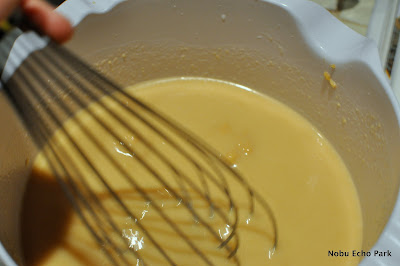I think of this as a Matsuhisa signature dish, but maybe only because I have ordered it every time I have eaten at Matsuhisa. This dish is delicious, and very easy.
From the cookbook.
Again, this recipe encapsulated another recipe, Saikyo Miso. This miso sauce is used to marinate the cod for 2-3 days, something I find a little frightening having in my head the idea that one should cook fish the day one buys it. Nevermind.
Matsuhisa-san calls for 4 x .5 lb black cod fillets, however having eaten this dish in his restaurant, I can tell you he is not serving .5 lb fillets. At Nijiya Market, the black cod is pre packaged in .25 lb fillets, and just eyeballing them, this seems about the right size for both the restaurant and home service.
Off on a 2-day road trip for work I marinate the black cod in the morning at 6 AM prior to leaving with the assistance of my sous chef, Carrie. First I wash the fillets thoroughly. I love how the skin of the fish almost matches the metallic mesh of my colander.
Saikyo Miso includes just a few ingredients. Sugar, white miso paste (an entire container), sake (I only had unfiltered in the fridge) and mirin.
Whisk the ingredients together.
Cook, in order to dissolve the sugar crystals and burn off the alcohol from the sake.
Once cooled to room temperature, layer the fillets in between sauce.
All cod fillets should be completely covered with miso marinade.
Cover, I used aluminum foil which in my mind I still call tin foil from my childhood, closely and refrigerate for 2-3 days.
Returning home from my road trip, one day in the OC, one beautiful day and one tough day in the desert, here are the cod after three days in the fridge. It smelled rather fishy, to be honest.
Matsuhisa-San suggests wiping the miso gently from the fillets, but not rinsing. Having made miso marinated fish many times using no recipe, my methodology is to not wipe off the marinade. I love the flavor of a miso marinade, and don't find it to be texturally prohibitive. So I didn't do as told.
Cooking. First broil the fish until brown. Typically, I stop here. I have found in the past that my fish after broiling is cooked through.
However, I want to try to stay fairly true to Matsuhisa-San's techniques. Therefore, after browning, bake in a 400 degree oven for 10-15 minutes. Above is the fish just prior to baking.
The end result turns out to be perfection. The baking process takes the fish from simply cooked through after broiling, to a beautiful translucent, soft, and buttery texture. Incredibly delicious. The spouse unit declares the flavor, texture and presentation are exactly alike what we have experienced at Matsuhisa in the past. I think we should dine there again sometime soon to find out!
He handled the beverages.































